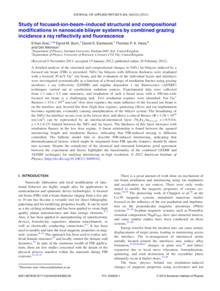
Study of focused-ion-beam induced structural and compositional modifications in nanoscale bilayer systems by combined grazing incidence x ray reflectivity and fluorescence
E. Arac, D.M. Burn, D.S. Eastwood, T.P.A. Hase and D. Atkinson
J. Appl. Phys. 111, 044324 (2012)
DOI: 10.1063/1.3689016
A detailed analysis of the structural and compositional changes in NiFe/Au bilayers induced by a focused ion beam (FIB) is presented. NiFe/Au bilayers with different thickness were irradiated with a focused 30 keV Ga+ ion beam, and the evaluation of the individual layers and interfaces were investigated systematically as a function of a broad range of irradiation fluence using grazing incidence x ray reflectivity (GIXRR) and angular dependent x ray fluorescence (ADXRF) techniques carried out at synchrotron radiation sources. Experimental data were collected from 1.3 mm × 4.5 mm structures, and irradiation of such a broad areas with a 100-nm-wide focused ion beam is a challenging task. Two irradiation regimes were identified: For Ga+ fluences < 15.6 × 1014 ion/cm2 (low dose regime), the main influence of the focused ion beam is on the interface and, beyond this dose (high dose regime), sputtering effects and ion implantation becomes significant, eventually causing amorphization of the bilayer system. The broadening of the NiFe/Au interface occurs even at the lowest dose, and above a critical fluence (Φ = 1.56 × 1014 ion/cm2) can be represented by an interfacial-intermixed layer (NixFeyAu(1-x-y); x = 0.5-0.6, y = 0.1-0.15) formed between the NiFe and Au layers. The thickness of this layer increases with irradiation fluence in the low dose regime. A linear relationship is found between the squared intermixing length and irradiation fluence, indicating that FIB-induced mixing is diffusion controlled. The ballistic model fails to describe FIB-induced intermixing, indicating that thermodynamical factors, which might be originated from FIB specific features, should be taken into account. Despite the complexity of the chemical and structural formation, good agreement between the experiment and theory highlights the functionality of the combined GIXRR and ADXRF techniques for studying intermixing in high resolution.